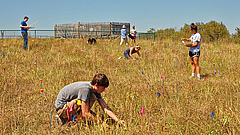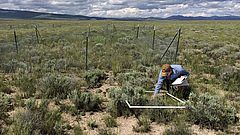New evidence that diversity has a positive effect on biomass production

The Doane audubon Spring Creek Prairie site in Nebraska is a typical grassland which covered during former times great areas of the Midwest of the United States. Photo: Ramesh Laungani, Doane College

The U.S. Sheep Experiment Station (USSES) is an agricultural experiment station focusing on domestic sheep which is run by the United States Department of Agriculture's Agricultural Research Service in Idaho. Photo: Peter Adler, Utah State University
Note for the media: Use of the pictures provided by iDiv is permitted for reports related to this media release only, and under the condition that credit is given to the picture originator.
The biodiversity and productivity of ecosystems are important to human well-being and, at the same time, are highly impacted by human activities. The relationship between biodiversity and productivity remains a fiercely debated topic due partly to numerous, often conflicting underlying theories. Biodiversity has been hypothesized to be of critical importance for the stability of natural ecosystems and their abilities to provide positive benefits such as oxygen production, soil genesis, and water detoxification to plant and animal communities, as well as to human society. Many of the efforts of conservation agencies around the world are driven by the assumption that this hypothesis is true. While theoretical studies have supported this claim, scientists have struggled for the last half-century to clearly isolate such an effect in the real world.
To determine this the scientists used data collected for this research by a global consortium, the Nutrient Network, from over a thousand grassland plots spanning five continents. The network is coordinated by the University of Minnesota and examines natural meadows and pastures ecosystems at more than 70 locations worldwide research. In Germany plots near Papenburg (Lower Saxony), Jena (Thuringia) and Bad Lauchstädt (Saxony-Anhalt) are part of the network. For the study, the team evaluated data from 1126 plots on 39 grasslands. Using recent advances in analytical methods, the group was able to isolate the biodiversity effect from the effects of other processes, including processes that can reduce diversity. “This study shows that you cannot have sustainable, productive ecosystems without maintaining biodiversity in the landscape,” says Professor James Grace of the US Geological Survey, who led the study.
A key finding of this paper is the positive effect that greater plant species diversity had on biomass production; this confirms extensive experimental results, but showing this effect in natural, un-manipulated systems has been a challenge until now. “Impressively, the multivariate structural equation model explained more than 60% of the variation is plant species richness in these natural ecosystems. Furthermore, the underlying environmental drivers of biodiversity and richness differed, which has important implications for understanding diversity and productivity patterns at a global scale”, says Professor Stanley Harpole of UFZ/iDiv/MLU. He is one of the founders of the Nutrient Network.
The researchers found also strong and independent influences of macroclimate and soils on richness and productivity. If climate change leads to reduced species or genetic diversity, which is a real possibility, that then could lead to a reduced capacity for ecosystems to respond to additional stresses.
The new published results provide a rigorous framework towards experimentally testing the causal mechanisms that allow species to coexist and for ecosystems to provide the services that we depend on. A take-home message is that only by using theory-based multivariate causal modelling approaches, can we move towards predicting the multiple and interacting effects of human-driven global change.
Publications:
James B. Grace, T. Michael Anderson, Eric W. Seabloom, Elizabeth T. Borer, Peter B. Adler, W. Stanley Harpole, Yann Hautier, Helmut Hillebrand, Eric M. Lind, Meelis Pärtel, Jonathan D. Bakker, Yvonne M. Buckley, Michael J. Crawley, Ellen I. Damschen, Kendi F. Davies, Philip A. Fay, Jennifer Firn, Daniel S. Gruner, Andy Hector, Johannes M. H. Knops, Andrew S. MacDougall, Brett A. Melbourne, John W. Morgan, John L. Orrock, Suzanne M. Prober & Melinda D. Smith (2016): Integrative modelling reveals mechanisms linking productivity and plant species richness.
Nature (14 Jan 2016). doi:10.1038/nature16524
http://dx.doi.org/10.1038/nature16524The study was founded by the US Geological Survey, the National Science Foundation (NSF) (Research Coordination Network (NSF-DEB-1042132) & Long Term Ecological Research (NSF-DEB-1234162 to Cedar Creek LTER) programs) as well as the UMN Institute on the Environment (DG-0001-13).
The current issue of Nature published also a comment (N&V article):
Kevin Gross (2016): Biodiversity and productivity entwined.
Nature (14 Jan 2016). doi:10.1038/nature16867
http://dx.doi.org/10.1038/nature16867Links:
Nutrient Network (NutNet)
http://www.nutnet.umn.edu/http://environment.umn.edu/biodiversity/nutnet-new-model-for-global-research/Further Informationen:
Prof. Stanley W. Harpole
Physiological Diversity / Department head at the Helmholtz Centre for Environmental Research (UFZ), Head of Research Group at the German Centre for Integrative Biodiversity Research (iDiv) and Professor at the Martin Luther University Halle-Wittenberg
Phone: +49 341 9733171, +49 341 33152
https://www.idiv.de/en/the-centre/employees/details/eshow/harpole-stan-w.htmlhttp://www.ufz.de/index.php?en=33124andProf. James Grace
US Geological Survey, Lafayette, Louisiana, United States
Phone: +1 337 266 8632
https://profile.usgs.gov/gracejorVic HinesUS Geological Survey, Public Affairs Contacts for Press Inquiries
Phone: +1 813-855-3125
http://www.usgs.gov/newsroom/contacts.aspandTilo ArnholdiDiv Public Relations
Phone: +49 341 9733197
https://www.idiv.de/en/press/people.htmlandSusanne HufeUFZ Public Relations
Phone: +49 341 2351630
https://www.ufz.de/index.php?en=640andManuela Bank-ZillmannPublic Relations at Martin Luther University Halle-Wittenberg
Phone: +49 345 5521004, +49 345 5521438
http://www.pr.uni-halle.de/mitarbeiter/

